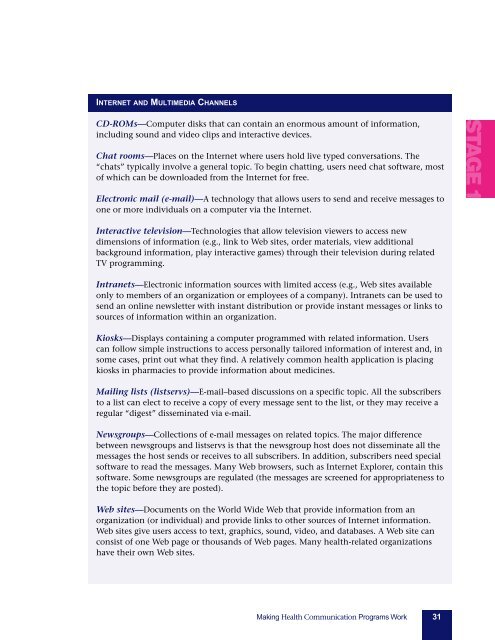pink-book
pink-book
pink-book
Create successful ePaper yourself
Turn your PDF publications into a flip-book with our unique Google optimized e-Paper software.
INTERNET AND MULTIMEDIA CHANNELS<br />
CD-ROMs—Computer disks that can contain an enormous amount of information,<br />
including sound and video clips and interactive devices.<br />
Chat rooms—Places on the Internet where users hold live typed conversations. The<br />
“chats” typically involve a general topic. To begin chatting, users need chat software, most<br />
of which can be downloaded from the Internet for free.<br />
Electronic mail (e-mail)—A technology that allows users to send and receive messages to<br />
one or more individuals on a computer via the Internet.<br />
STAGE 1<br />
Interactive television—Technologies that allow television viewers to access new<br />
dimensions of information (e.g., link to Web sites, order materials, view additional<br />
background information, play interactive games) through their television during related<br />
TV programming.<br />
Intranets—Electronic information sources with limited access (e.g., Web sites available<br />
only to members of an organization or employees of a company). Intranets can be used to<br />
send an online newsletter with instant distribution or provide instant messages or links to<br />
sources of information within an organization.<br />
Kiosks—Displays containing a computer programmed with related information. Users<br />
can follow simple instructions to access personally tailored information of interest and, in<br />
some cases, print out what they find. A relatively common health application is placing<br />
kiosks in pharmacies to provide information about medicines.<br />
Mailing lists (listservs)—E-mail–based discussions on a specific topic. All the subscribers<br />
to a list can elect to receive a copy of every message sent to the list, or they may receive a<br />
regular “digest” disseminated via e-mail.<br />
Newsgroups—Collections of e-mail messages on related topics. The major difference<br />
between newsgroups and listservs is that the newsgroup host does not disseminate all the<br />
messages the host sends or receives to all subscribers. In addition, subscribers need special<br />
software to read the messages. Many Web browsers, such as Internet Explorer, contain this<br />
software. Some newsgroups are regulated (the messages are screened for appropriateness to<br />
the topic before they are posted).<br />
Web sites—Documents on the World Wide Web that provide information from an<br />
organization (or individual) and provide links to other sources of Internet information.<br />
Web sites give users access to text, graphics, sound, video, and databases. A Web site can<br />
consist of one Web page or thousands of Web pages. Many health-related organizations<br />
have their own Web sites.<br />
Making Health Communication Programs Work 31


